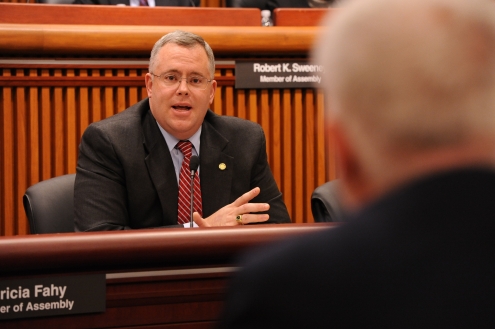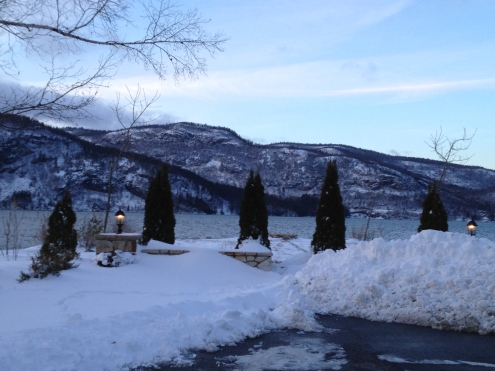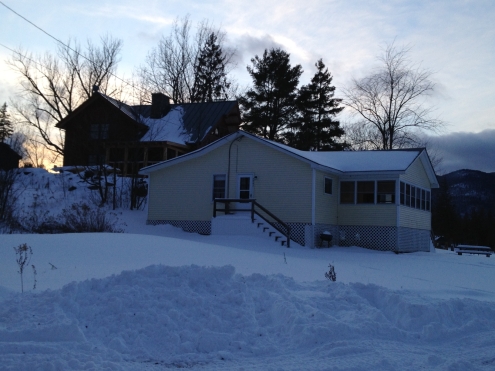The Lake George Land Conservancy is accepting applications for one summer stewardship assistant position. This person will be part of a team of two, working to keep LGLC trails safe, monitor conservation easements, lead hikes and help out with other organizational projects as needed. For a full job description click here.
Daylight Saving Time
Daylight Saving Time officially begins in the United States at 2:00 AM on Sunday, March 10th.
I’ve been a bit under the weather this week so it feels good to hit this mark, because spring is getting close.
Who Needs a Tree?

A gray squirrel in a tree during the summer of 2012.
I recently received the 2013 tree order form from the Washington County Soil and Water District. So if you’re looking to purchase any type of tree; from Black Walnut all the way to White Oak, here’s a chance support our local soil and water conservation district.
Wednesday Weather Update
Things have been incredibly slow lately, so here’s what’s happening with the weather today. There wasn’t much accumulation of snow last night and there’s been mostly rain and sleet today.
It’s one of those nasty wet winter days, that hopefully signals that the weather is getting warmer.
As Cold as Ice
A picture of Lake George taken this past President’s Day weekend.
Blizzard Nemo Aftermath: Monday Afternoon
Stec Talks Lake George with DEC Commissioner

Assemblyman Dan Stec, questions DEC Commissioner, Joseph Martens, at Monday’s budget hearing in Albany.
Assemblyman Dan Stec, the Ranking Member of the Assembly Environmental Conservation Committee took part in a hearing on Monday with Department of Environmental Conservation (DEC) Commissioner Joseph Martens. Stec, a strong supporter of promoting and protecting our lakes, relished the opportunity to discuss the issues affecting vital resources such as Lake George.
“Lake George is crucial to my district, not only as a tourist attraction and source of revenue, but as a treasured part of our community’s history,” said Stec. “Ensuring that we protect this body of water and others like it is essential to the continued promotion of outdoor recreation and economic development in our region.
“I would like to thank Commissioner Martens for taking the time to discuss topics like invasive species and waterway protection. With his input, we can better figure out strategies to ensure our lakes and bodies of water remain the jewels of our community they are today.”
Video of the discussion with Commissioner Martens can be seen below:
httpv://youtu.be/fBwNFRS3JYw
Now For Some History: Febuary 4, 1973
“Winter is with us; raw, cold, mild, all the time, snow all around us, lake frozen with a big crack in the ice right through the middle from Rogers Rock to Bolton Landing. It broke open with a big boom heard all around us; Whitehall, Fair Haven, even Glens Falls. About every day a storm, rain, freezing and everything, or more snow. We just try to get by till spring.”
Excerpted from a letter written to Pat Brotman
from Huletts resident, Irene Phillips.
February 4, 1973
(40 years ago.)
Land Conservancy Appoints Five to Board of Directors

Dr. John Buhac, Charles M. Cumming, Debbie Hoffman, (left to right, top row) JD DeSantis, and Daniel J. Ryterband (left to right, bottom row).
The Lake George Land Conservancy (LGLC) is pleased to announce the appointment of five new members to its board of directors: Dr. John Buhac, Charles M. Cumming, JD DeSantis, Debbie Hoffman, and Daniel J. Ryterband.
“The very heart of volunteerism is giving time, energy and expertise to the mission of an organization,” said LGLC Executive Director Nancy Williams. “Our Directors demonstrate their commitment to the lake by joining LGLC which gives us the benefit of their experience and passion for the lake.”
Dr. Buhac is a gastroenterologist who has been in private practice in the Albany area since 1998. He is a graduate of Cornell University and received his medical degree from Tufts University School of Medicine. Dr. Buhac grew up in the Albany area and has been exploring the Adirondacks, New England and the Lake George area since childhood. The family purchased their camp in Gull Bay in 2009, and enjoy it year round. Winter is a favorite time, as the focus turns from the Lake centered activities of summer, to hikes and ski or snowshoe visits to the Gull Bay preserve. Dr. Buhac has two children and is married to Dr. Jean Buhac, a dermatologist practicing in Saratoga Springs, NY. They spend all their free time sailing, kayaking, hiking, skiing, and just reading by the lake or puttering in their log cabin.
Mr. Cumming received a B.A. degree in psychology from Dartmouth College and an M.B.A. from the University of Connecticut. He served as a Commissioned Officer in the U.S. Army from 1965 to 1967. For the majority of his career, Mr. Cumming was a management consultant specializing in employee and executive compensation programs. He frequently consulted to Board of Directors of many large corporations and non-profits. He retired from consulting in 2001 and spends his time enjoying his home on Lake George and engaging in various volunteer activities.
Ms. Hoffman is the CFO of the Northway 8 Golf Shop and Driving Range in Clifton Park, which she opened in 1974 with her husband, Bill. Having first visited Lake George in 1968 on their first date, they continued to take every opportunity to cruise the lake and hoped that someday they would have a place on the lake. After Mr. Hoffman’s retirement in 2004, they realized their dream and bought a home on the historic Apperson Lane in Bolton Landing. Since purchasing the camp, Ms. Hoffman began volunteering in the area, serving as the president of the Lake George Community Garden Club from 2009-2011, and helping the Lake George Land Conservancy with mailings and event preparations. As a member of the Board she has also taken on an active role on the finance and development committees and on the events sub-committee.
Mr. DeSantis is a graduate of Dartmouth College with a major in environmental studies and he received his law degree from the New York University School of Law. He is currently a partner at Shearman & Sterling LLP where he specializes in representing investment banks and corporations in leveraged buyouts, issuances of high yield bonds and leveraged loan transactions. JD spent much of his childhood in Lake George, sailing in the summers and skiing in the winters. JD and his wife Leah continue to spend summers in Lake George and look forward to being able to introduce their children Felix, George and Roxy to all of the activities that make Lake George so special.
Mr. Ryterband is the president of Frederic W. Cook & Co., a consulting firm providing services to corporate Board Compensation Committees. He received his B.S. in environmental and business economics from Rutgers University, and is M.B.A. in finance and management from New York University’s Stern School of Business. He has 23 years of experiences as a consultant, including the last six serving as president of F.W. Cook. He and his wife, Dianne, have three children and own a vacation home in Diamond Point. Mr. Ryterband enjoys hiking and snowshoeing, all types of fishing, and all things Adirondack, and is an avid stamp collector and postal historian.
LGLC Sale Challenge
The Lake George Land Conservancy has been offered a challenge by a generous landowner: if the LGLC can find a buyer for one of their three subdivided house lots, the owner will agree to protect the remaining two from development with a conservation easement. That’s over 200 feet of protected shoreline and over 5 acres of land that will remain protected.
The LGLC is pleased to offer this incredible opportunity for a buyer to purchase one of the few remaining large shoreline properties on Lake George. Enjoy the stunning views of Anthonys Nose from your very private property! The buyer will purchase 8.08 +- acres of land and over 350 feet of shoreline on a beautiful private cove on Lake George. This property is located in Putnam, New York just southeast of the community of Glenburnie on Lake George. This nature lovers dream parcel is offered for $494,990.
Situated on the north side of Warrick Road the property is within walking distance of nearly 900 acres of preserved land including LGLC’s Anthonys Nose, the Last Great Shoreline, and Gull Bay Preserve. Over ninety-nine species of birds inhabit this land with Bald Eagles and Peregrine Falcons nesting on the cliffs of Record Hill.
Working with the buyer, a mutually agreed upon plan will be developed that permits one house site, ancillary uses (such as garage, driveway, dock) and viewshed clearing. The remaining land will be protected under a perpetual conservation easement. The easement will prohibit further subdivision but permit sustainable forestry. This beautiful forested parcel could supply plenty of wood for your fireplace. Three moorings and docks are permitted under the regulations of Lake George Park Commission; however, one mooring-right will be retained by the current land owners. The property has over 380 feet of road frontage on Warrick Road, a shared driveway, power available within the property and an approved septic area. The Town of Putnam maintains the graveled road and plows during the winter. There are recorded protective covenants and a driveway maintenance agreement. The tree and shrub canopy will be permitted to be kept open for unsurpassed views of the Lake and Anthonys Nose and Record Hill. The LGLC is not taking a commission for this sale.
For more information contact Nancy Williams at the LGLC.
A Winter Walk

My brother, sister-in-law, and niece, Margot Kapusinski, stopped by yesterday and before it was too late went for a walk. If you’ve never been in Huletts in the winter, what is most noticeable is the stillness. Here are three pictures which capture the mood of the day. These pictures were taken on Friday. Today, it is snowing again.
(Click on images to see full-scale.)
Lake George Land Conservancy 2013 Scholarship Essay Contest
The Lake George Land Conservancy has announced information about their 2013 Scholarship Essay available to High School Seniors, including home-schooled students, whose school district has students living within the Lake George Watershed: Bolton Landing, Lake George, Ticonderoga or Whitehall (students who are year-round residents of Hulett’s Landing).
Submit an essay between 1000 and 2000 words covering the annual question. The questions will be creatively based in exploring the relationship of land and water – specifically, dealing with the relationship’s impact on the water quality within the Lake George Watershed. Essays are to be submitted to the Lake George Land Conservancy (LGLC) via email to hbartonbenedict@lglc.org. Please use the LGLC’s website, www.lglc.org, as a reference or call 518-644-9673. Winning essays will be posted on LGLC’s website.
2013 Essay Question:
What will Lake George be like 200 years from now? What will your descendants be doing on and around Lake George, and how will their experiences on Lake George be different from yours today?
Milestone Reached: Construction Completed on West Brook Stormwater Complex

A rendering of what the West Brook Conservation Initiative in Lake George village will look like when completed. The “south parcel” stormwater complex is located on the bottom of the drawing, West Brook runs horizontally through the center, and the public festival space in located on the “north parcel” on top. The southern end of Lake George can be seen in the upper right hand corner.

Facing north from the “south parcel” of the West Brook Conservation Initiative. West Brook is beyond the railing in the background. The large pond in the foreground can be seen in blue on the drawing that appears at the top of this post.
The water in Lake George flows from the south to the north. So if the water from the south is cleaner, then the water in the north should be cleaner also.
That is the hope of those building the West Brook Conservation Initiative in Lake George village. The entire site can be thought of as two areas; respectively called the south and north parcels, with West Brook flowing between the two. The north parcel, once home to the “Cavalcade of Cars” and the “Opera House,” will include public festival space, a children’s adventure play area, and a skateboard park. The south parcel will include the stormwater treatment complex with interpretive educational trails throughout.
Construction of the south parcel stormwater treatment complex is now officially complete. All of the partners and supporters in the West Brook Conservation Initiative have something to celebrate. While the stormwater treatment system will not be technically “turned on” until the plants take root, it is expected that by the spring of 2013, the stormwater runoff from the Route 9 corridor and adjoining properties will be directed into the treatment basin.

Facing east from the “south parcel” of the West Brook Conservation Initiative. The new stormwater complex nears completion. Many people will remember that “Gaslight Village” and “Charlie’s Saloon” once occupied the south parcel.

Over 20,000 native plants, shrubs, and trees were installed in October, marking the final phase of construction on the stormwater complex.
The system will filter many of the pollutants that currently enter the south end of the Lake via West Brook. Engineers estimate that 90% of the sediment now flowing into the Lake will be treated by this system and over one-half of the pollutants will be removed. Millions of gallons of untreated stormwater now flow untreated into the south basin of Lake George.
The next phase of the project includes finishing the interpretive trails throughout the south parcel and constructing the public festival space on the north parcel.
Funding is in place for most of the construction needed for the north parcel: the park building (housing the restrooms), the children’s adventure play area, the skateboard park (90% funded), the walkways and interpretative signage, and an at-grade crossing over West Brook. Funding is also in place for the walkways and interpretative signage on the south parcel (through the storm water treatment train).
In approximately three weeks, word is expected on grants that could complete the funding needed for several park elements. Elements to be potentially funded through these grants are:
a. the final 10% of the skateboard park;
b. walkways;
c. park entrance at Beach Road; and
d. signage as well as sidewalks along West Brook Rd.
The project partners are continuing to look for funding sources for the elevated walkway and bridge over West Brook, connected to a fire tower, the Rt. 9 entrance, and the water feature.
Finally, the construction documents for funded elements are presently being completed. Once the grant award announcements are made, the park management committee will decide which additional construction documents will be needed, and those will be completed over the winter. Contractors will bid next summer, and construction will start shortly thereafter. Construction is slated for completion in the summer of 2015.
Gull Bay Cleanup

Some of the garbage volunteers cleaned up at the Gull Bay Preserve.
Lake George Land Conservancy volunteers joined together on October 18th to clean up an old dump site at the Gull Bay Preserve, north of Huletts Landing. The group also helped to install gates at key points to limit illegal access by ATVs and other vehicles.

Truck load of trash removed from old dump site.
Those in attendance responded to the Lake George Land Conservancy’s call to help clean up an old dump site at the northern end of the Gull Bay Preserve. In addition to a truck and other large scrap pieces, there were bags of bottles, cans and other typical household trash. The group removed as much as could be loaded into LGLC’s truck; the rest will be removed or covered at a later time.

Lake George Land Conservancy volunteer Mike O’Reilly. Mike is the VP of Finances and Treasurer on the LGLC’s Board of Directors, and a resident of Hulett’s Landing.
One gate was installed at a major access point for ATVs and other motorized vehicles into the preserve. Use of these vehicles is illegal on private property, cause damage to trails and forest habitat, and disrupt wildlife, including the great blue herons which are sensitive to noise and human activity. By reducing or eliminating vehicle use on the property the Lake George Land Conservancy hopes that vegetation will fill in and restore damaged trails, and that the reduction of noise will encourage more wildlife to utilize the land.









